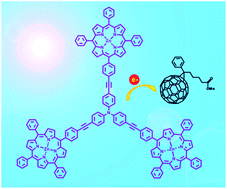On the potential of porphyrin-spiked triarylamine stars for bulk heterojunction solar cells†
Abstract
A novel

* Corresponding authors
a Program in Petrochemistry and Polymer Science, Faculty of Science, Chulalongkorn University, Bangkok 10330, Thailand
b
Department of Chemistry, Faculty of Science, Chulalongkorn University, Bangkok 10330, Thailand
E-mail:
patchanita.v@chula.ac.th
Fax: +66 2-254-1309
Tel: +66 2-218-7587
c Linz Institute for Organic Solar Cells (LIOS), Institute of Physical Chemistry, Johannes Kepler University, Linz 4040, Austria
A novel

 Please wait while we load your content...
Something went wrong. Try again?
Please wait while we load your content...
Something went wrong. Try again?
T. Kengthanomma, P. Thamyongkit, J. Gasiorowski, A. M. Ramil and N. S. Sariciftci, J. Mater. Chem. A, 2013, 1, 10524 DOI: 10.1039/C3TA11095H
To request permission to reproduce material from this article, please go to the Copyright Clearance Center request page.
If you are an author contributing to an RSC publication, you do not need to request permission provided correct acknowledgement is given.
If you are the author of this article, you do not need to request permission to reproduce figures and diagrams provided correct acknowledgement is given. If you want to reproduce the whole article in a third-party publication (excluding your thesis/dissertation for which permission is not required) please go to the Copyright Clearance Center request page.
Read more about how to correctly acknowledge RSC content.
 Fetching data from CrossRef.
Fetching data from CrossRef.
This may take some time to load.
Loading related content
